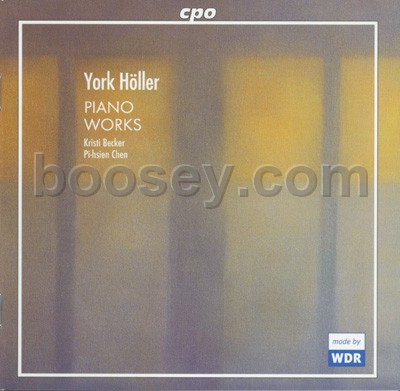Boosey & Hawkes
The work is based on a 23-note, spirally-formed, open ‘sound-shape’, whose interval structure and inherent harmony (four chords of 2, 4, 7 and 10 notes each) form the melodic and harmonic structure of the pieces. The projection of the pitch relations onto the time scale produces ‘time shapes’, which determine the metric developments in each of the six pieces in a characteristic way. Though the titles of the individual pieces, as well as that of the whole cycle, seem to refer to baroque models, they are actually aimed at formal archetypes, which may be outlined as follows:
1. Preludio: Intonation, embellishment and varying illumination of the ‘keynote’ D.
2. Fuga polimetrica: here a strictly related and superimposed structure from the ‘sound-shape’ and ‘metric shape’ appears unsynchronised i.e. the first piano is staggered six bars ahead of the second.
3. Fantasia I: A kind of ‘improvisation’ on individual segments of the ‘sound-shape’, i.e. its compression as intervals, evolves from a 23-note chord (the ‘sound-shape’ vertically projected).
4. Conductus: Over the ostinato-like repetition of the retrograde ‘sound-shape’, several rhythmically independent layers, each with a distinct pattern, pile up into a complex polyphony.
5. Fantasia II: Delicate lines and their ‘shadows’ develop out of the prolonged initial notes of the ‘sound-shape’.
6. Gigue: ‘Drummed’ triplets, repeated at a furious tempo, open a crazy ‘Pas de deux’. At its centre, the music flows into a quotation of the beginning of "Général Lavine - eccentric…", that scurrilous piece from the Préludes which Debussy composed, fascinated with a performance by the star dancer Lavine in the Folies Mavigny.
The Partita is indebted to the spirit of Johann Sebastian Bach and Claude Debussy, the spirit whose polarities Bernd Alois Zimmermann always encouraged me to blend and transform.
York Höller
Reproduction Rights
This programme note can be reproduced free of charge in concert programmes with a credit to the composer
"The Partita is a kind of suite in six parts, ‘indebted to the spirit of Bach and Debussy’, as Höller writes in the program notes. His play with chords and metres, however, is less indebted to the strictness of Bach than to the sound world of Debussy, though he does not exaggerate the impressionist moods.
Starting from the key note D, which is at first repeated in a tender manner, reminiscent of the sound of a little bell, then surrounded with additional notes, Höller builds his structures. Gradually the harmonics and metrics become more complex, an excited Fugue is heard, or a sensual Fantasia, created out of broken chords in middle or high register. The concluding Gigue features a strong dramaturgical form, a presto movement with powerful dynamics of movement.
The performing ladies make a huge effort and, for all the accurate construction of this work, are always aware of the sounds, the rhythmic pulse and the harmonic subtleties of the music."
(Martin Schrahn, Ruhr Nachrichten, 13 Aug 1997)
"The audience at the Ruhr Piano Festival liked York Höller’s Partita. The composer received so much applause that the performers, Elena Bashkirova and Brigitte Engerer, had to give an encore of two of the six movements. Indeed a rare success for a contemporary work."
(Gregor Willmes, Westdeutsche Allgemeine Zeitung Essen, 13 Aug 1997)

Kristi Becker / Pi-hsien Chen
CPO 999 954-2 (2003)
